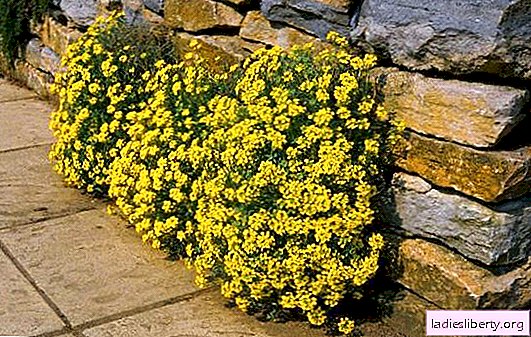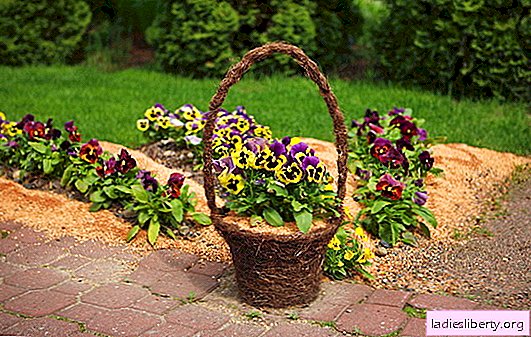
Alyssum is an amazingly beautiful shrub that belongs to the Cabbage family. Today, there are more than 170 species that are grown in Europe. Among them there are both perennial and annual varieties of alissum.
An unusual shrub is a decoration of any garden. The shoots of the plant branch well, covering the soil tightly. Leaves are small, oblong, bluish, pubescent. Simple four-petalled flowers are collected in racemose inflorescences. Alyssum is a good honey plant, attracts pollinating insects with its aroma. Coloring of flowers can be white, yellow, pink or lilac. The plant conquered gardeners with its long flowering, which begins in early spring and continues until autumn. With proper care, flower brushes become larger.
Growing alissum in the garden: how to use and with what to combine the plant
Alissum flowers go well with other perennials. They are placed in a group with Turkish carnations, dwarf irises and tulips, marigolds, phlox. To achieve contrast, alissums are planted with other plants that bloom in blue and red.
Honey aroma can be emphasized by placing decorative and deciduous plants next to the shrub. Designers often use this flower to create rock gardens, rockeries, and all kinds of flower beds.
Varieties of perennial alissum (photo)
Long-term decorative culture is divided into three types:
• Alyssum is rocky;
• Sea alissum;
• Ampel.
Rock alissum - This is a perennial plant with well-branching shoots, the height of which reaches about 30 cm. Its distinctive feature is that the flowering of this species lasts more than a month. With age, the plant needs anti-aging procedures, as the shoots are exposed. Rosettes consist of leaves of a bluish color. The bush is densely covered with yellow inflorescences that are collected in a brush. If you place two plants side by side, then during the flowering period the bushes look like a continuous bright carpet.
The flowering period of this species occurs in early spring. With good care, the reappearance of peduncles is possible in the fall. As a rule, it occurs in varieties with white-colored flowers.
Varieties of rock alissum (photo)
• Golden wave - this variety blooms in the second year after planting. The plant is low, forms a dense carpet of yellow color. Looks good in self-landing and in a group with other perennials. The variety is very fragrant.

• Plenum - a variety with terry golden flowers.

• Citrinum - used to design a border. The plant blooms in lemon color.
• Compactum - the variety gives small fragrant inflorescences. Plant height reaches only 18 cm.
Sea alissum is distinguished by its tart aroma. Perennial shrub grows in a warm climate, reaches a height of about 40 cm. It is widespread in coastal regions. Lush bushes with creeping branches. Marine plant species exude the aroma of honey. The herbaceous shrub is undemanding in care, however, regular pruning of old shoots stimulates lush flowering. Hybrid forms grow well on fertilized soils.
The most decorative is the ampelous alissum, which is widely used for growing in hanging planters, landscaping terraces and arbors. The most common was the variety Esther Bonnet, which is grown in baskets. The plant looks like a lush white ball strewn with many small flowers. To create an effective composition, you will need several plants in one flowerpot.

Cultivation of perennial alissum: planting, care, reproduction (photo)
Location selection
Alyssum is an unpretentious plant that grows well in open sunny areas. In the shade, he also feels good, but flowering is not so memorable.
The landing site needs to be selected dry, well-drained in a sunny area. The decorative shrub is not whimsical to the soil, but acidic soils and wetlands are not suitable for its cultivation. Neutral substrates should be preferred.
Alyssum tolerates heat well, does not suffer from a lack of watering. It is able to bloom even in dry years, but the duration of flowering is reduced. Excessive watering is detrimental to the bush. However, young plants need high humidity.
A place for growing alissum should be spacious, as young shoots grow rapidly. A month after planting, with good care, the plant covers a fairly large area. Experienced flower growers recommend planting bushes at a distance of up to 30 cm.
Soil preparation and planting
Perennial varieties of shrubs are grown through sowing seeds for seedlings, which allows for earlier flowering. For this, the soil is prepared in advance by adding lime to it. Seeds are evenly distributed over the surface of the soil. Sprinkle them with earth is not necessary. They need light to germinate. The containers are covered with glass or a bag, placed in a warm bright place. When the first shoots appear, the glass must be removed. Seedlings are quite small, care should be taken carefully. Pick-up in separate cups is carried out in the phase of four real leaves.

In order for the bush to branch well, you need to pinch the seedling when it reaches a height of about 10 cm. After some time, such plants become covered with inflorescences. Seedlings tolerate planting well in open ground.
Experienced gardeners sow seeds directly into the ground. You need to do this in the fall or early spring. Winter sowing is carried out when the earth has not yet cooled. But if the weather is warm, then shoots may appear that need good shelter for the winter.
Important! Sowing seeds before winter allows you to get plants that bloom before the rest. At the same time, their flowering is more magnificent.
Spring sowing of seeds is carried out when the air temperature reaches at least +15 degrees. Young shoots need good care: watering, weeding. Thinning seedlings is carried out after they are sufficiently strong. After the procedure, at least 15 cm should remain between the plants. Such plants bloom no earlier than July.
Alissum care after planting
The plant does not require any special care. The whole process comes down to cutting and trimming. After the winter, all broken shoots and dried leaves are removed. At the end of summer, flower stalks and weak branches should be removed, which stimulates repeated flowering at the end of the season.
Regular feeding of alissum has a good effect on the condition of the plant. Make-up needs to be done twice a season. Fertilize the plant with mineral complexes or organics. This gives him strength for growth and abundant long flowering.
With improper care and non-compliance with the irrigation regimen, alissum is exposed to the following diseases: gray rot, powdery mildew, rust and spotting. All of them are formed in conditions of high soil moisture. Sick plants destroy. As a preventive measure, it is necessary to reduce the level of humidity of air and soil, to carry out spraying with special preparations.
Reproduction of perennial alissum
Experienced gardeners successfully propagate perennial plant varieties by dividing the old bush and cuttings. Cutting should be done in the summer. Separated shoots are planted in light nutrient soil well watered.
The division of the bush is carried out in the spring, during the period of planting seeds, somewhere in early May. For this, the old bushes are dug up, separated with a sharp knife so that there are enough shoots on each of them. In a new place, the plant is well looked after: well watered, shaded, weed.

Varieties of annual alissum
Many gardeners prefer to grow an annual alissum - lobularia. This plant is quite attractive, forms lush bushes. Today, many varieties of lobularia are known:
• The Snow Queen;
• Golf;
• Vanilla cloud.
In landscape design, a combination of annual and perennial alissum varieties is very often used, which complement each other.
Annual species reproduce only by seeds, which are sown immediately on the beds. The best time for sowing: the end of April or the beginning of May. If the nights are still cold, then the bed should be covered with non-woven covering material. After the seedlings get stronger they can be transplanted to a permanent place. Care for the annual alissum includes watering, weeding and fertilizing. Seed collection is carried out after their maturation.











